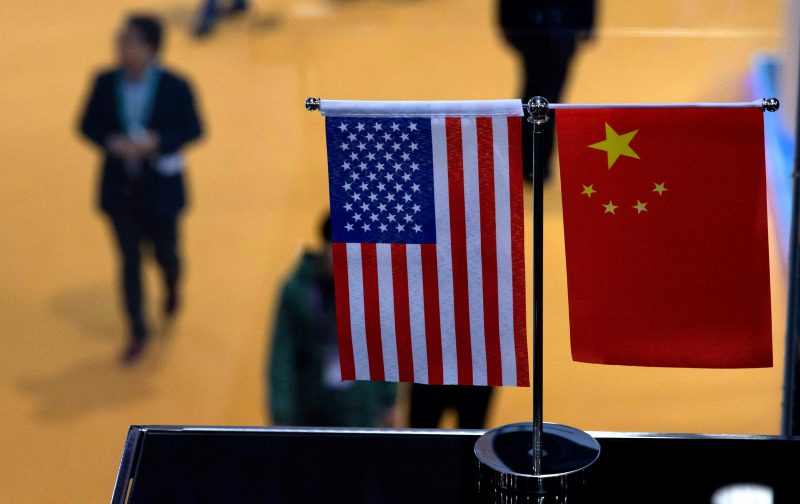US-China trade talks resume, Trump says deal still ‘possible’
High-stakes trade talks between the United States and China resume in Washington Thursday evening (JOHANNES EISELE)
Washington (AFP) – US and Chinese officials returned to the bargaining table late Thursday amid a sudden flare-up in hostilities, while President Donald Trump held out hopes of salvaging a trade deal.
The Chinese delegation, including Vice Premier Liu He, was greeted by US Trade Representative Robert Lighthizer and Treasury Secretary Steven Mnuchin.
With punishing US tariffs on hundreds of billions in Chinese merchandise due to jump after midnight, Trump told reporters he had received a letter from his Chinese counterpart Xi Jinping, and would likely speak to him by telephone later.
“It’s possible to do it,” Trump said of the trade deal at the White House. “I did get last night a very beautiful letter from President Xi.”
But Trump warned he was also more than happy to use tariffs in resolving his differences with China.
“I am different than a lot of people. I happen to think that tariffs, for our country, are very powerful.”
Months of increasing comity and optimism in trade talks appeared to go up in smoke this week as American officials accused China of a wholesale retreat from previously agreed commitments — a claim Beijing strongly rejected.
“They took many, many parts of that deal and they renegotiated. You can’t do that,” Trump said Thursday.
Since early this year, the trade talks have worked to resolve Washington’s grievances of industrial theft, massive state intervention in markets and a yawning trade deficit.
China’s Commerce Ministry warned Beijing would not “capitulate to any pressure” and threatened retaliation if US tariffs go up to 25 percent as scheduled on Friday — punctuating the drastic deterioration after months of seemingly collegial talks.
“The Chinese side has kept its promises and this has never changed,” he added, without specifying what measures Beijing would take but warning that it “has already prepared for all possible situations.”
Since last year, the two sides have exchanged tariffs on more than $360 billion in two-way trade, gutting US agricultural exports to China and weighing on both countries’ manufacturing sectors.
The International Monetary Fund repeated its warning on Thursday that the trade battle between the world’s top economies was a “threat” to global growth, and called for a rapid resolution.
– ‘Fundamental misunderstanding’ –
Meanwhile, the US Commerce Department reported that the trade deficit with China hit a three-year low in March, with US exports to China rising while imports, such as mobile telephones, fell.
The renewed tensions roiled global stock markets this week and unnerved exporters caught off guard.
But word of Xi’s letter appeared to soothe Wall Street’s nerves somewhat on Thursday, with the benchmark Dow Jones Industrial Average recovering some of the day’s sell-off but still closing down 0.5 percent.
Markets in Europe and Asia also sank again.
Derek Scissors, a China expert at the American Enterprise Institute, told AFP the two sides had clashed over how much of the final trade agreement should be enshrined in publicly available document, something Beijing has long resisted.
“There was a fundamental misunderstanding,” he told AFP by email.
“President Trump faces a political battle selling a China deal as being worthwhile. To do so, he needs a public document with clear gains for the US,” Scissors said.
“But what China is willing to acknowledge in public is less than it is willing to acknowledge in private.”
He noted that “the two sides failed to realize that they have very different tolerance for transparency.”
But Scott Kennedy a trade expert at the Center for Strategic and International Studies said China had misjudged the Americans’ eagerness to cut a deal at all costs.
“They didn’t realize when they pulled their concessions off the table that the administration would have the reaction that it did,” he told AFP.
Kennedy warned that the “possibilities for miscalculation on both sides is pretty high.”
Chinese producers said the abrupt tariff hike announcement wreaked havoc on operations and would bring high costs, layoffs and further shifts of production to Southeast Asia.
“If the tariffs go up to 25 percent, costs will go up. Customers so far have suspended orders. I don’t know what will happen,” said Emily Wang of Hainan Zhongyi Frozen Food, which exports tilapia.
Washington has demanded far-reaching changes to the Chinese economy, such as subjecting state enterprises to market principles, reducing massive subsidies and ending the alleged theft of US technology.
Analysts say China will be reluctant to make many of these changes, which could undermine the Communist Party’s political power.
While US companies complain of lost export markets, disrupted supply chains and higher costs, the US continues to see steady growth and falling unemployment.
But each side believes it is better positioned than the other to survive the dispute, Kennedy said.
The Chinese “don’t see themselves as fragile and they see the US as having grown very quickly as a result of a tax cut that the US can’t afford,” he said.
burs-dg/hs
Disclaimer: Validity of the above story is for 7 Days from original date of publishing. Source: AFP.


